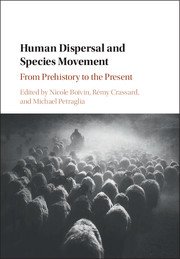Book contents
- Frontmatter
- Contents
- List of text boxes
- List of figures
- List of tables
- List of contributors
- Preface
- I Introduction
- II Origins: Species Movements in the Pleistocene
- III Across the water: Species movements by Coast and Sea
- IV Complexity: Species Movements in the Holocene
- V Invasion: The Movement of Invasive and Disease Species
- 15 Invasive eusocieties: Commonalities between ants and humans
- 16 Invasives, aliens, and labels long forgotten: Toward a semiotics of human-mediated species movement
- 17 Multiple time scales for dispersals of bacterial disease over human history
- 18 Early malarial infections and the first epidemiological transition
- 19 The globalisations of disease
- 20 Modern day population, pathogen and pest dispersals
- Index
- Plate section
- References
16 - Invasives, aliens, and labels long forgotten: Toward a semiotics of human-mediated species movement
from V - Invasion: The Movement of Invasive and Disease Species
Published online by Cambridge University Press: 04 May 2017
- Frontmatter
- Contents
- List of text boxes
- List of figures
- List of tables
- List of contributors
- Preface
- I Introduction
- II Origins: Species Movements in the Pleistocene
- III Across the water: Species movements by Coast and Sea
- IV Complexity: Species Movements in the Holocene
- V Invasion: The Movement of Invasive and Disease Species
- 15 Invasive eusocieties: Commonalities between ants and humans
- 16 Invasives, aliens, and labels long forgotten: Toward a semiotics of human-mediated species movement
- 17 Multiple time scales for dispersals of bacterial disease over human history
- 18 Early malarial infections and the first epidemiological transition
- 19 The globalisations of disease
- 20 Modern day population, pathogen and pest dispersals
- Index
- Plate section
- References
Summary
Abstract
Invasive alien species have in recent decades become a major concern in such fields as conservation, agriculture, and medicine. Linked to human mobility, the movements of plants, animals, and microbes have accelerated over the last century, ushering in the new field of invasion biology. Past observers of transported organisms have variously labelled them as exotic, foreign, non-native, alien, and invasive, amongst other terms, depending on the characteristics of the organism and the circumstances and viewpoints of the observer. Historic meanings and connotations of such labels provide insights into changing attitudes toward such organisms, while also providing clues concerning their movement, extent, and number. The shifting labels applied to alien species also emphasizes the subjectivity of these words, and the caution required in employing them, as well as their ability to shape our views of the natural world.
Keywords: Invasive alien species, invasion biology, environmental history, etymology, semiotics
As the chapters in this volume clearly demonstrate, species move. But as soon as humans become the agent that moves species – accidentally or purposely − by jet, ship, wagon, boot, scalp, or gut, such species are deemed exotic, non-native, introduced, alien. The act of picking up a species and then carrying it along with us forever alters our judgement of it. ‘Alien’ is a term for foreign humans as well as foreign creatures, and if ‘invasive’, such creatures spread on their own after being transported to their new home. Invasive alien plants, animals, and microbes are often considered an irredeemable other, unless they moved by their own means, in which case they are usually considered indigenous. Such native creatures are always home if they can adapt and evolve to new conditions they encounter while moving. If humans were not the ones who transported a creature, then this creature seems to be as suitable as we are – has as many rights as we do – for living in a place. Yet classifying species into alien or native can be controversial. A group of biologists controversially implored colleagues not to judge a species on its origins (Davis et al. 2011), even though not doing so would run counter to the conventions of centuries of categorizing naturalists. Davis’ group explained that while there are certainly undesirable creatures, not all aliens are undesirable.
- Type
- Chapter
- Information
- Human Dispersal and Species MovementFrom Prehistory to the Present, pp. 430 - 453Publisher: Cambridge University PressPrint publication year: 2017
References
- 1
- Cited by



